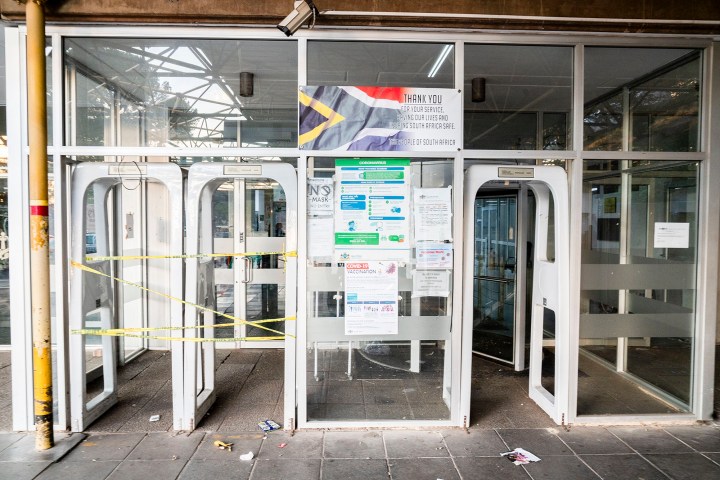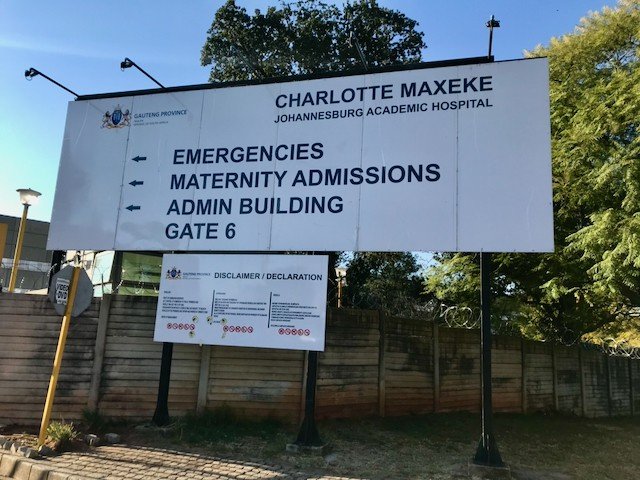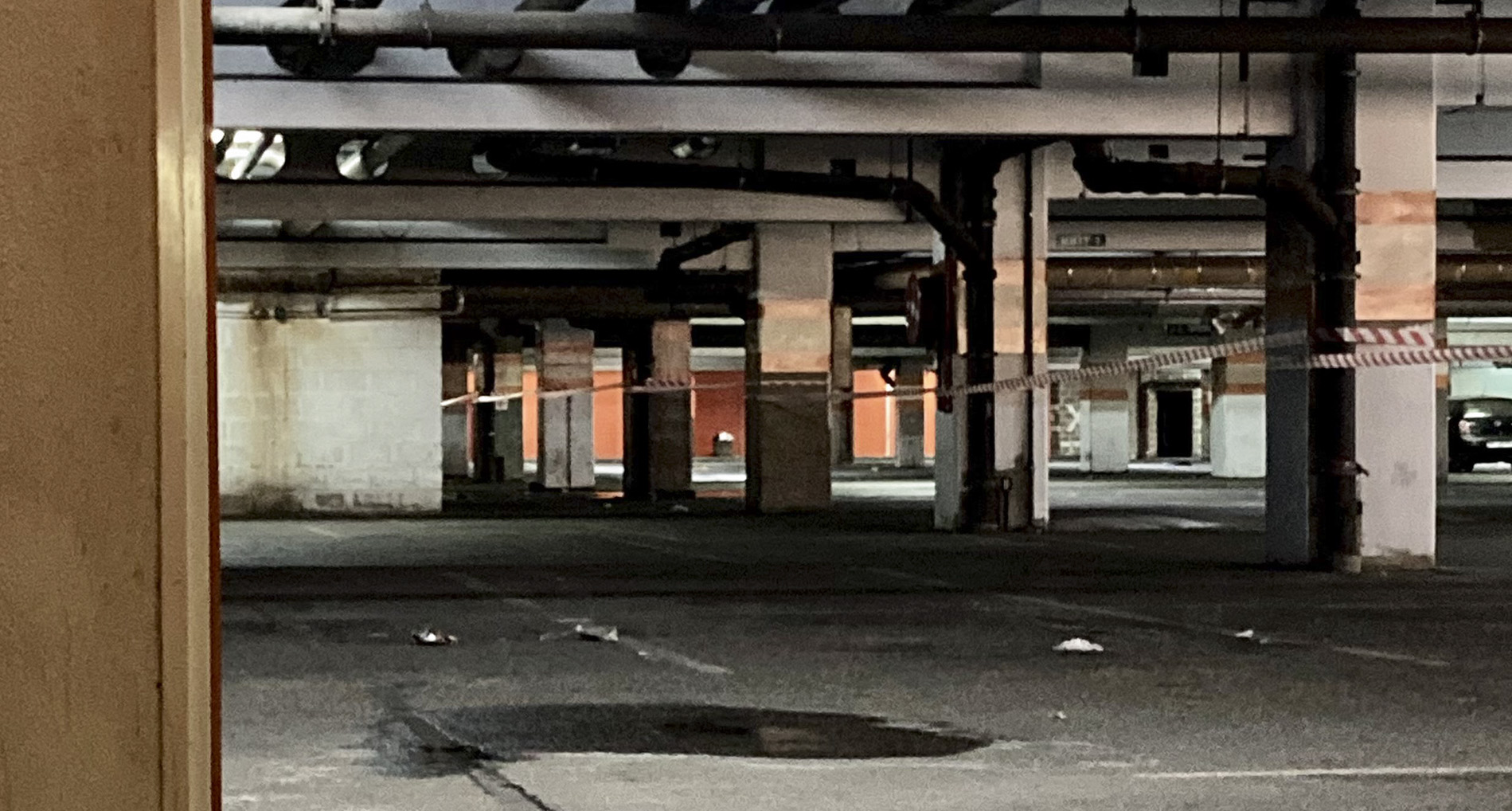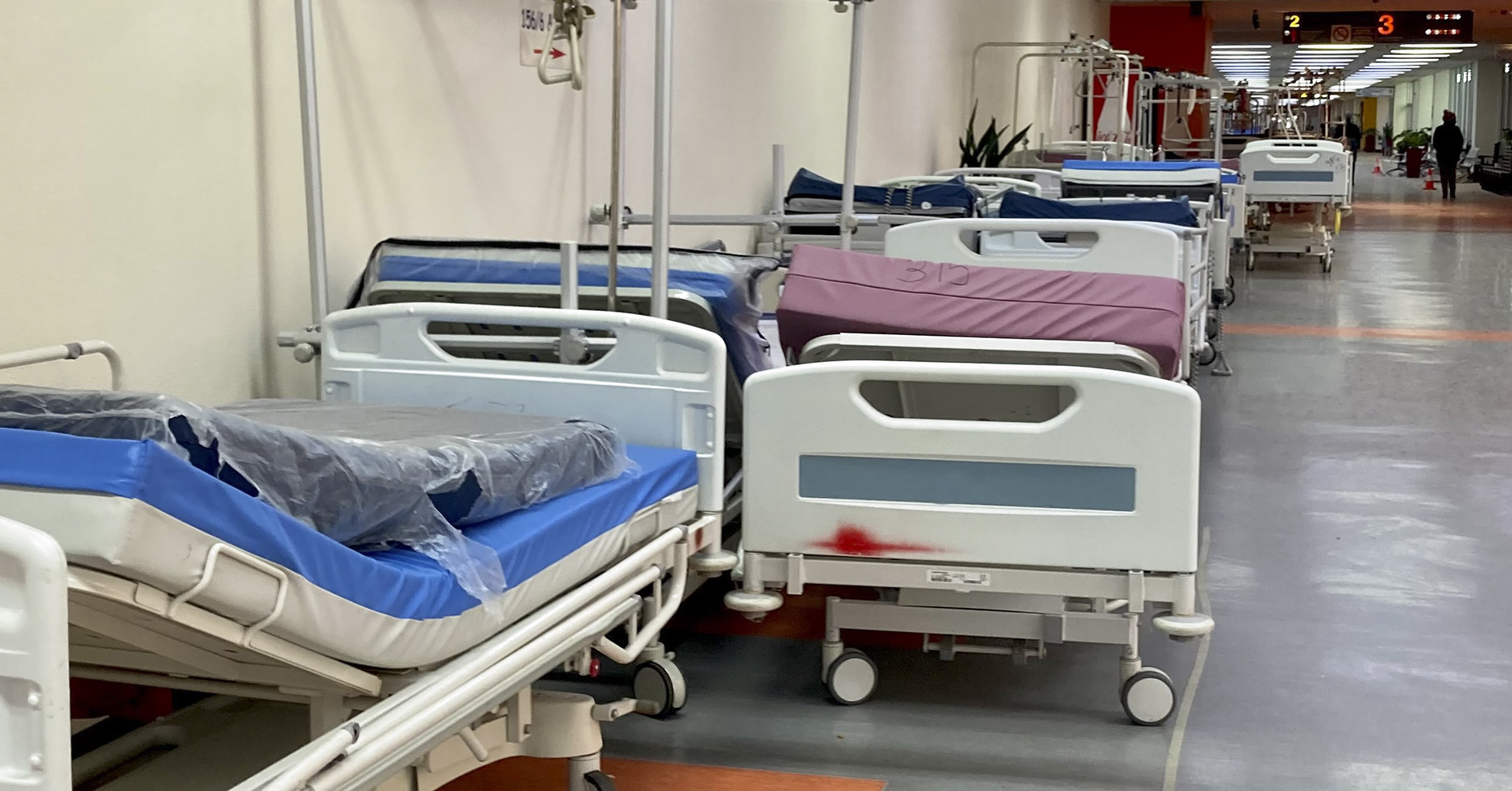SPOTLIGHT UPDATE
Charlotte Maxeke Hospital is still gasping for breath, a year after it flatlined in a fire

Twelve months after the fire at Charlotte Maxeke Academic Johannesburg Hospital, there’s damning evidence of missteps and delays in maintaining health and safety standards, plus sabotage and incompetence in managing the rebuild. With dire knock-on effects for the province’s healthcare system.
Charlotte Maxeke Johannesburg Academic Hospital (CMJAH) flatlined on 16 April 2021, the day of the fire. A year later, Johannesburg’s one-time premier public-sector hospital is still fighting for its life.
On what should be a busy Friday morning in autumn, things are muted at the hospital that rises on the Parktown ridge, a landmark in the city since it opened its doors in 1979. There are no urgent wailing ambulance sirens or spinning emergency lights rushing patients to the hospital. Ambulances stopped coming a year ago, when the casualty department closed. It hasn’t yet reopened.
A lone security guard sits in the foyer area at casualty. Her only company for the morning is a sign for “porters” propped up against a wall.
Charlotte Maxeke Hospital’s casualty unit used to be world-renowned. Its expertise in managing high volumes of trauma cases successfully attracted trainees and visiting faculty and medical students from around the world. In turn, the academic hospital was a training ground credited for polishing trauma doctors and surgeons, many of whom went on to become world leaders in their fields.
Ostensibly, the hold-up for re-opening is because a broken CT scanner – a critical piece of equipment for trauma cases – cannot be fixed till a missing part is acquired. A year later, this has not happened.
Missed deadlines
Ayanda Dakela, head of health facilities and infrastructure at the National Department of Health (NDoH), was tasked with overseeing the rebuilding project in February. It came after months of inaction and infighting between the Gauteng Department of Health (GDoH) and Gauteng Department of Infrastructure and Development (GDID).
Responding to Spotlight’s questions, his office acknowledges incidents of vandalism and theft at the unit. “The CPU for the CT scanner was stolen, and cables for the scanner were cut into pieces. Two distribution boards were stolen, and a few copper pipes were stolen.”
Dakela adds that three GDID technical officials were arrested in connection with these crimes.

Charlotte Maxeke Johannesburg Academic Hospital has been closed since a fire broke out in April 2021. (Photo: Masego Mafata)
It all amounts to another missed deadline. In February, the hospital senior management and officials from the national and provincial health departments held a media conference confirming a reopening date for the unit as mid-March. Later this was shifted to April. At the end of April, it is still closed.

Level 4 parking at Charlotte Maxeke Johannesburg Academic Hospital, where burnt-out sections are cordoned off. (Photo: Supplied)
Quiet parking levels
Back at CMJAH, it’s the silence you notice first. But then you start joining the dots about how the lack of parking space is impacting the day-to-day running of the hospital.
The April fire broke out on the parking levels of the building and raced up nine floors. These sections have been closed off. It means finding a parking spot is a scramble; even now there are no contingencies for alternative parking or shuttles to accommodate doctors, nurses, staff, patients or visitors.
People are mostly forced to park outside the hospital campus. They double-park and often obstruct traffic by parking in front of hospital gates at CMJAH’s different entrances. At the main entrance, people simply park in the incoming traffic lane, leaving vehicles that need to pass with no option but to drive into oncoming traffic lanes. There is no space to make a U-turn. While Spotlight was there, security made no effort to help prevent these jams.
Beyond being an irritation, the parking crisis means doctors can’t keep to schedules when they can’t find parking; ill patients have to walk longer distances and patient transport is delayed.
A patient navigator for oncology patients told Spotlight that some days she simply gives up trying to get into the hospital and resigns herself to instead trying on another day.
“You end up fighting with the security guards, who just sit there and don’t help direct traffic. Then I give up because I have other appointments. But you feel bad because you know you are carrying the files of people who need to start treatments as soon as possible,” she said.
Morale drain
For staff already pushed to the limit after being at the forefront of fighting the Covid-19 pandemic, the parking fiasco is the final straw. Morale is in a nosedive at CMJAH, and each month brings more doctors’ resignations.
A senior doctor summed it up to Spotlight: “You get frustrated when you can’t find a parking at the mall; now imagine that every day you come to work and that’s what you have to deal with. As you work, you worry that your car has been stolen or broken into, or that when you walk to your car after your shift, you might be robbed or attacked.”
Inside the hospital, more failings become clear. While the main walkway, called Hospital Road, is busy with people connecting to different sections of the hospital, it’s now also a waiting area. In part, it’s a measure to ensure patients keep to social distancing. But it’s also because nine wards were closed down from the fire, meaning even corridors have had to be repurposed. At the cardiology unit, out-patients are forced to wait in stairwells or on chairs lined up outside the elevator areas. It’s one of the specialist wards that is still only partially reopened.
Cancer backlogs continue
The oncology unit was out of operation for almost four months after the fire. CMJAH was the only public hospital in Johannesburg where radiation treatment was available; the next closest facility being Steve Biko Academic Hospital in Tshwane, 55km away.
But reopening hasn’t cleared the backlog of patients who need treatment. The backlog has just kept enlarging. According to The Cancer Alliance, a collective group of cancer non-profits and activists, some patients have been on the waiting list for two years. Many die before they make their next appointment dates. They have also started to notice that patients’ cancers are returning, having fallen through the cracks for treatment during the months of the fire shutdown. The Cancer Alliance has repeatedly warned that the unit was already buckling because of the unaddressed crisis of staff and equipment shortages mounting for years before the fire.
A Gauteng Department of Health press release in March said the province had invested more than R500-million in the procurement of five Linac linear accelerator cancer treatment machines in the past two financial years. These are used for radiation beam treatment. However, it went on to state that “a machine meant for CMJAH is yet to be commissioned”. The department also acknowledged that “CMJAH and Steve Biko Academic Hospital do not have enough human personnel to run all the machines at full capacity”.

Beds lined up along Hospital Street at Charlotte Maxeke Johannesburg Academic Hospital. (Photo: Supplied)
Closed wards
Entire wards at CMJAH are still closed down. It’s noticeable by the bright green scaffolding struts that start at the bottom floors at the parking areas, and run up throughout affected sections of the building.
Some sections, like the psychiatric clinic, have been abandoned. The walls here are still covered in soot and water marks. Hospital furniture and debris still fill the corridors. There’s just a handwritten note on the door that reads: “558 moved to Helen Joseph”.
The knock-on effect is that Helen Joseph Hospital has been swamped with psychiatric patients, and forced to accommodate people in the emergency ward of the hospital that is not equipped to manage patients with psychoses. It became a risk to patients who could harm themselves, other patients and staff.
In responding to specific questions about contingencies for psychiatric patients, Gauteng Health’s spokesperson Kwara Kekana only forwarded a press release dated 25 March, presented as a joint statement by Minister of Health Dr Joe Phaahla and Gauteng MEC for Health Dr Nomathemba Mokgethi.
It states: “Helen Joseph Hospital has increased its mental healthcare bed capacity, as well as repurposing a temporary structure to house more patients.”
It also “acknowledge[s] that this intervention is still not enough to address the increase in demand”.
Work continues
Meanwhile, the continued presence of the green temporary support structure looms as a constant reminder of the fact that a year after the fire, much of the hospital remains on life support. Rental costs for the scaffolding amounts to an estimated R5 to R8-million a month, according to a hospital insider. The company providing the structure, Viva Formwork & Scaffolding, gave notice at the end of March that it intended to remove the support structures, citing non-payment by government. Since then, NDoH has said it has had to extend the contract with a new negotiated rate that will run until 15 May 2022.
But in the joint statement by the Minister and MEC, the pair also acknowledged that the accrued debt in the province stands at R5.8-billion, and dates as far back as 2013. They acknowledged that the debt “affects the cash flow of the department and our ability to pay suppliers on time”.
There are other signs that work has happened at a stuttered pace at best, over the past year at CMJAH. The project to install fire doors is incomplete, leaving some areas without doors at all. The absence of fire doors or working fire doors was one of the key reasons given by fire fighters who spoke to Spotlight as to why the fire could not be contained, and spread to cause the extensive damage that it did.
Spotlight requested a copy of the outstanding structural engineering assessment report and the outstanding fire report. Dakela however, confirmed that this was only undertaken at the beginning of April 2022, and said a preliminary report is now expected by 15 May. He also revealed the puzzling fact that no fire report or assessment was conducted “by the Department of Infrastructure Development since April 2021 to date”.
Currently, authorities put the work undertaken to extend to “deep cleaning of blocks one to eight, installation of HVAC (heating, ventilation and air conditioning), health technology equipment, electronic fire detection, evacuation systems and wet fire installations. Applications for Occupational Health Safety approvals and certificates have been submitted to the City of Johannesburg and are being processed”.
Their target now is for completion of work to happen as follows: Emergency Unit by April 2022 (already missed); Block 1 by March 2023; Block 2 by July 2023; Block 3 by October 2023; Block 4 by November 2023, and Block 5 by November 2023.
The estimated budget is just under R1.1-billion. This will be raised from the Development Bank of South Africa and National Treasury’s emergency budget. NGOs are also helping out – the Solidarity Fund is responsible for the compliance requirements of the Casualty Department, Gift of the Givers will work on the new stores facilities, and the Spire Fund will work on a detailed assessment of areas in the hospital affected by the fire, the NDoH said. DM/MC
This article was published by Spotlight – health journalism in the public interest.


















 Become an Insider
Become an Insider
This is pathetic. Why was the hospital not insured, meaning that government and NGOs now have to find hundreds of millions for repairs? Why was the hospital not inspected immediately? As a Structural Engineer in industry, I was expected to get to the site of a fire and prepare a preliminary report within a day or two, followed by a full report within a few weeks. Why were fire doors and other fire equipment not working? The why’s go on and on. And in the mean time the incompetent Gauteng Health and Hospital management personnel continue getting their high salaries, while the people in desperate of health care suffer.